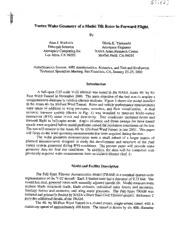
Vortex Wake Geometry of a Model Tilt Rotor in Forward Flight PDF
Preview Vortex Wake Geometry of a Model Tilt Rotor in Forward Flight
VortexWake Geometry of a Model Tilt Rotor in Forward FUght.. By Alan J. Wadcock Gloria K. Yamauchi Principal Scientist Aerospace Engineer Aerospace Computing Inc. NASA Ames Research Center. Los Altos, CA 94022 Moffett Field, CA 94035 : : Aerodynamics Session, AHS Aerodynamics, Acoustics, and Test and Evaluation Technical Specialists Meeting, San Francisco, CA, January 23-25, 2002 Introduction A full-span 0.25-scale V-22 tiltrotor was tested in the NASA Ames 40- by 80- Foot Wind Tunnel in November 2000. The main objective of the test was to acquire a comprehensive database to validate tiltrotor analyses. Figure 1 shows the model installed in the Ames 40- by 80-Foot Wind Tunnel. Rotor and vehicle performance measurements were taken in addition to wing pressures, acoustics, and flow visualization. A dual acoustic traverse system (shown in Fig. 1) was installed to measure blade-vortex interaction (BVI) noise levels and directivity. Test conditions included hover and forward flight in helicopter mode. Angle- of-attack and thrust sweeps for three tunnel speeds were acquired before model problems caused the premature conclusion of the test. The test will resume in the Ames 80- by 120-Foot Wind Tunnel in late 2001. This paper will focus on the wake geometry measurements that were acquired during the test. The wake geometry measurements were a small subset of a larger matrix of planned measurements designed to study the development and structure of the dual vortex system generated during BVI conditions. The present paper will provide wake geometry data for four test conditions. In addition, the data will be compared with previously acquired wake measurements from an isolated tiltrotor (Ref. 1) Model and Facility Description The Full-Span Tiltrotor Aeroacoustics Model (TRAM) is a nominal quarter-scale representation of the V-22 aircraft. Each 3-bladed rotor has a diameter of 9.75 feet. The model has dual, powered rotors with manually adjusted nacelle tilt. Model measurements include blade structural loads, blade airloads, individual rotor forces and moments, fuselage forces and moments, and wing static pressures. The Full-Span TRAM was initiated and primarily funded by NASA's Short Haul Civil Tiltrotor project. Reference 2 provides additional details of the TRAM. The 40- by 80-Foot Wind Tunnel is a closed circuit, single-return tunnel with a maximum speed of approximately 300 knots. The tunnel is driven by six 40ft. diameter 2. Johnson, J. L. and Young, L. A., "Tilt Rotor Aeroacoustic Model Project," Confederation of EuropeanAerospace Societies Forum on Aeroacoustics of RotorcraftandPropellersR, ome,Italy,June1999.. 3. SoderrnanP, .T.,Jaeger,S.M., Hayes,J.A. andAllen,C.S.,"Acousticperformance of the40-by 80-FootWindTunnelTestSectionDeepAcousticLining," 21"AIAA AeroacousticsConferenceL,ahaina,HI, June12-14,2000. Figure1. ModelInstallationinNASA Ames40-Ftx80-FtWind Tunnel ............ r ......................... TRAM.TC#1.KGdata.ver2 500 --.............. ............. !............................. !............................. :............................. :............................ ,,o-........,._......i......................)._..........."....-......°........i..-'; ....."..-._....:......_................... .f2- e 350 ..................i.......O............................................................i....................................... N i CLOCKWISE 300 ........................................................................................ !............................................................ 250 ..................................................................................................................................................... 200 J r ; f t i r i r i r I i i i _ a a _ I I0( 200 300 400 500 600 IX Figure 4. Sample wake trajectory measurements from LLS video, test condition 1.
